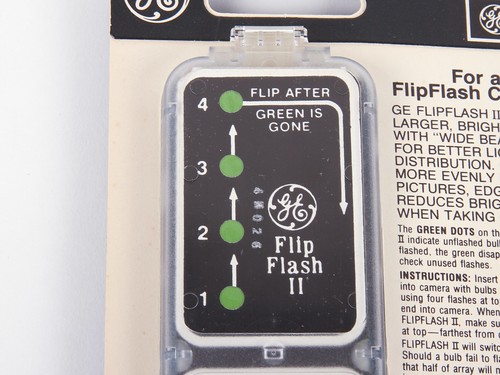Once upon a time, cameras did not come with LED illumination or even xenon strobes, but rather with a socket that could fire a one-time-use flashbulb.
An advance from this was the “flip flash” cartridge which held 8 or 10 flash bulbs, ganged up so that you could take one photo after another, without pausing to swap bulbs. Each time that you took a picture (exposing actual film!), the next flashbulb in the cartridge would fire.
But you might ask a tricky question here: How does it know which bulb to fire next?
In this day and age, we’re used to smart devices. If people were designing flashbulb cartridges today, each might have a tiny microcontroller or EEPROM to store its state — much like the controllers found in ink cartridges. Or perhaps each would just have a unique ID number, and it would be up to your camera to remember the state of any given flash that it had interacted with — much like a DVD player that remembers where a given disc was paused.

So how did they do it in the era before cheap integrated circuits? In several different very clever ways, with a common theme: Use the thermal energy released by the flash to wire up the next bulb to fire (and/or disconnect the last one to fire).
The various flash manufacturers (Agfa, Phillips, Polaroid, Sylvania, and GE) all made similar flash units, waging competition through minor improvements and patents, leaving quite a paper trail in the process.
US Patent number 4017728, assigned to GTE Sylvania in 1975 describes a method in which each flashbulb is wired up through a piece of conductive heat-shrink plastic that shrinks and breaks when the flashbulb fires.

In this diagram (Fig. 8) from the patent, when flashbulb 11 fires, it opens up thermal switch 47, and closes thermal switch 40. Then, only flashbulb 12 is wired into the circuit. When 12 fires, it opens up thermal switch 48 and closes switch 41, wiring flashbulb 13 into the circuit.
The need to wire the next bulb into the circuit is self explanatory. The need to disconnect the old bulb is less obvious. The issue is that a flashbulb does not always end up as an “open circuit” after it fires. In some cases, it may still be conductive though burnt out — and so high reliability requires that not only is the next bulb wired in, but that the last bulb is removed from the circuit.
The process of fusing a normally-open switch into a closed electrical connection is described separately in patent number 3458270, in which low-melting point Wood’s metal is used to build the connection. It tells you something about how much heat was released by one of the flash bulbs. Can you imagine trying to solder an electrical connection together with an LED flash?
Some clever variations on this theme leave a bright blue or green dot visible on the back side, to indicate how many flashes have been used up. But, in a close-up view of the version without the blue dot, we can see a big silver stripe from the back side. Quite possibly, that’s the electrically conductive heat shrink “wiring,” just waiting all these years to be melted.








Ahh yes, I remember going from the “cubes” to the “stick”
As a kid, I had a Kodak that used such a flash system. I was never much of a photographer; instead I disassembled these flash cartridges and used the bulbs and the camera, along with a long piece of stereo hookup wire, to remotely ignite fireworks, which worked a treat.
That’s a wonderful application. It should be in the instructions for use!
That’s in fact the first PCB I ever etched: a little one with only three traces and no components, that sat nicely in the camera where the flash cartridge ought to go.
My uncle used to use these for family portraits at holidays. Thanks so much for explaining how they worked. Neat use of waste heat.
I still have a kodak camera that uses those things but shortly after buying it, I upgrade to an electronic flast. I also have a couple of the flash stick left as well. I stopped using it when I had the money to by a real 35 mm camera but it took many pictures before it was retired. The big problem is modern scanners aren’t designed to work with a negative that small so it takes a bit of playing to get images off the negatives and into the computer.
I had a camera with the cube flash that rotated around to present the next flash and there was triggered by a small lever pushing up through a slot in the cube
Thanks for the post. I am a fan of the flash cube. As near as I can tell, the trigger is totally mechanical. I have a box of them and amaze students by moving a metal pin that is exposed on the bottom of the cube and the flash goes off. This was a pretty good classroom demo for conservation of mass after the chemical (flash) reaction.
Yeah, flashbulbs started as large bulbs the size of screw-in light bulbs. Then they got down to marshmallow size (M5), then acorn size (M3), and finally peanut size (AG1). Then they were replaced by flashcubes, which used 4 electrically fired AG1 size bulbs in a rotating frame. The rotation also connected the wires for the front-facing bulb. There were also “magicubes” which were mechanically fired by pushing a spring wire off a retaining tab so it snapped into position to fire the bulb. The Flip Flash (turn over for bulbs) and Flashbar (turn around for more bulbs) came after this. The Flashbar actually had a contact per bulb, and the camera had to do the work of detecting used bulbs and firing the proper one.